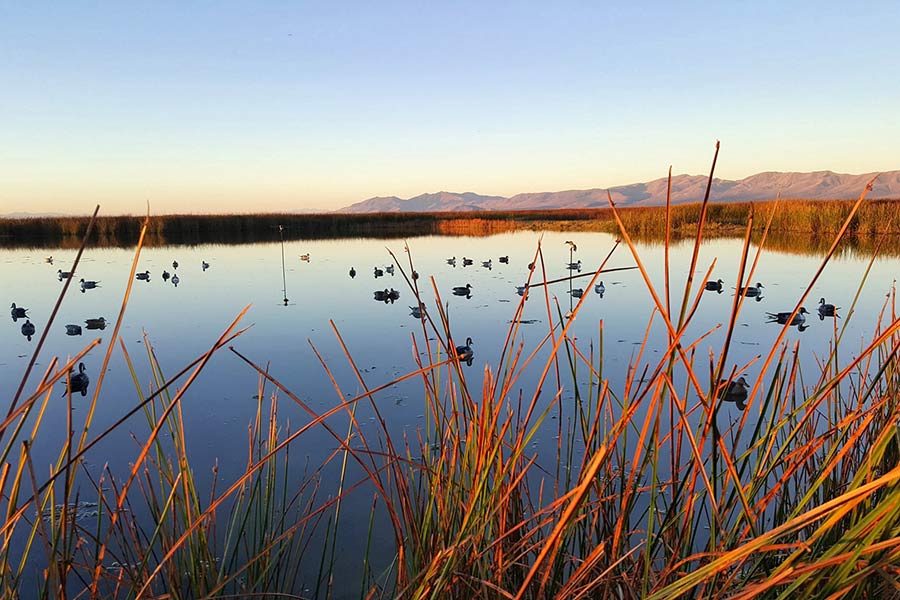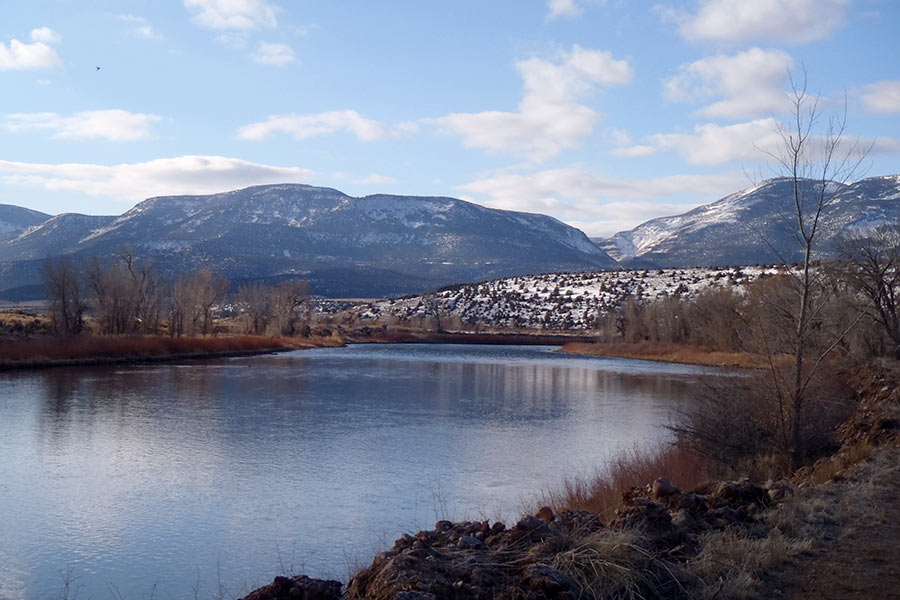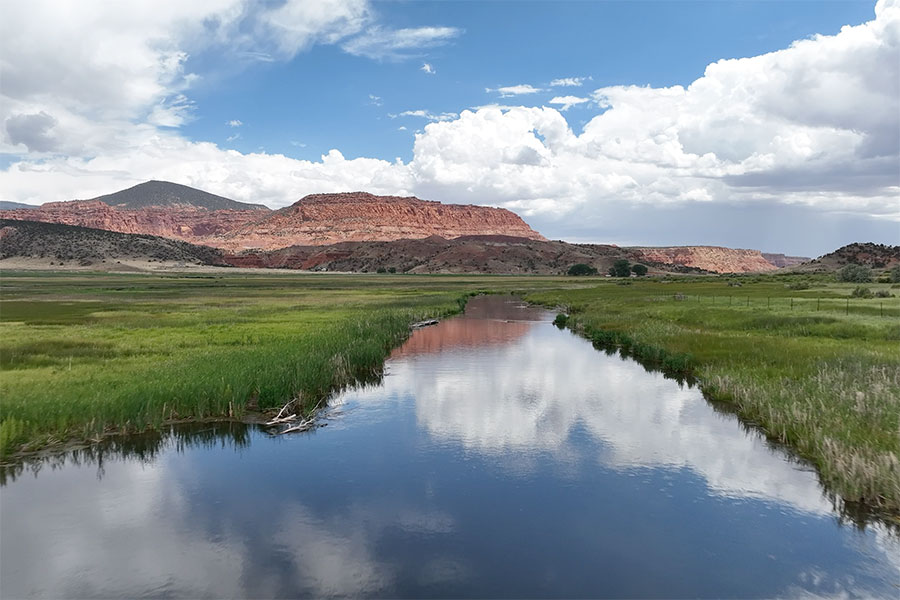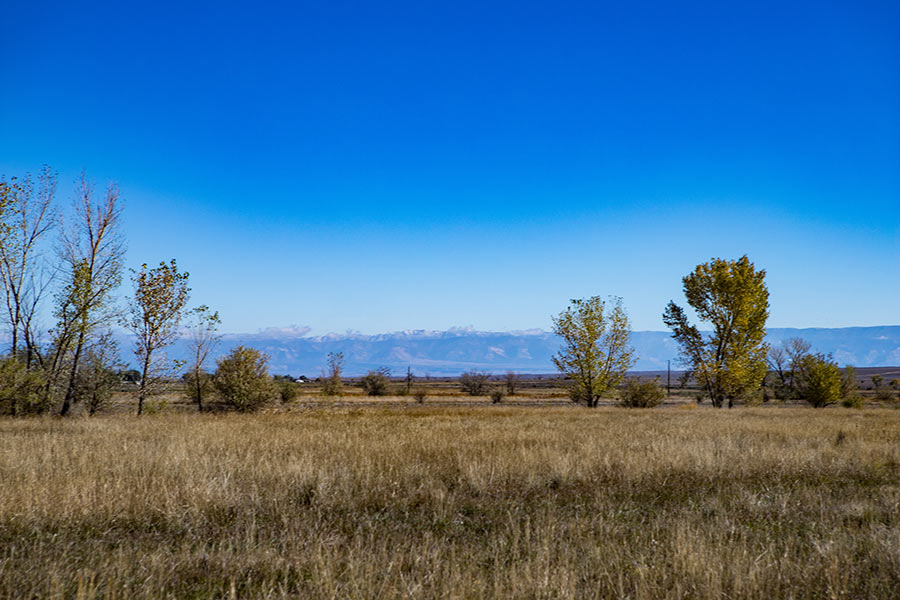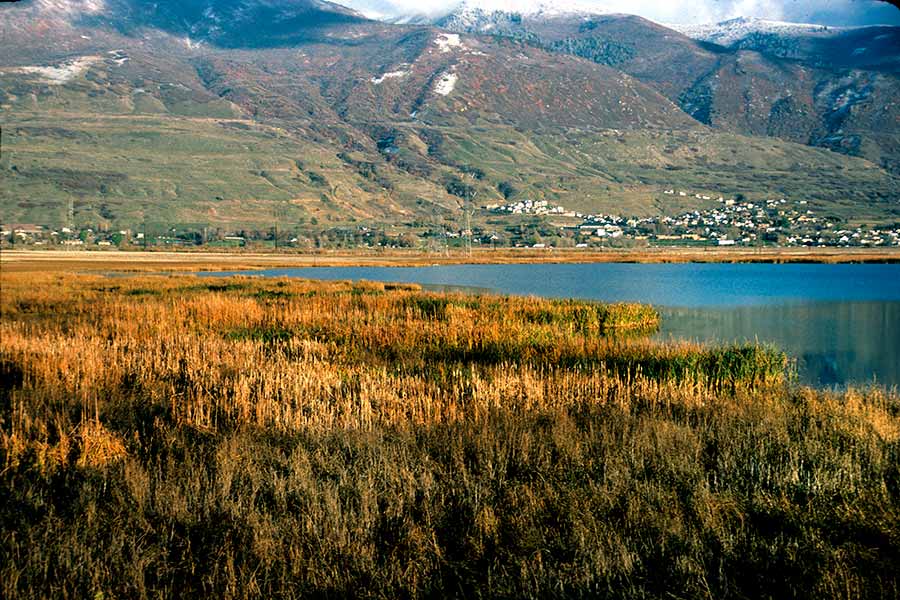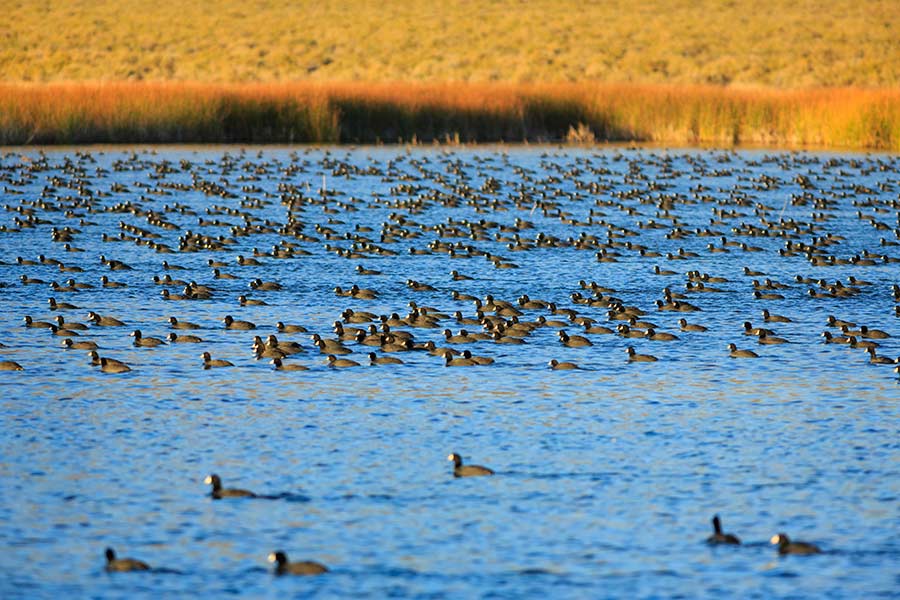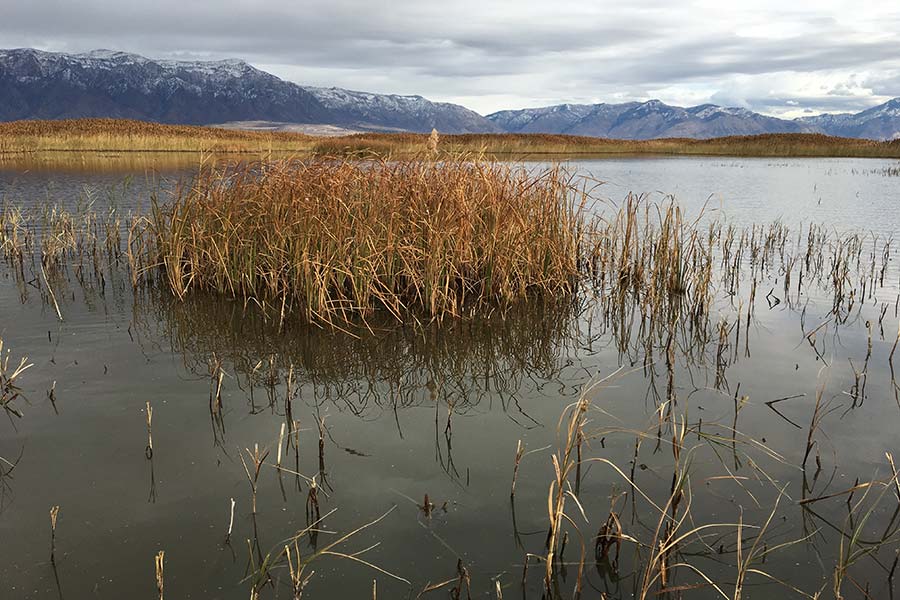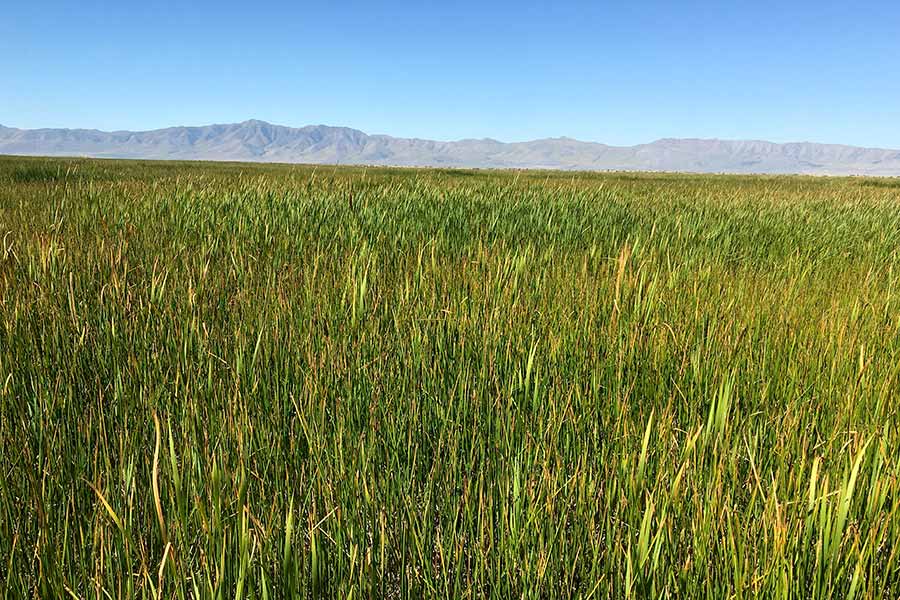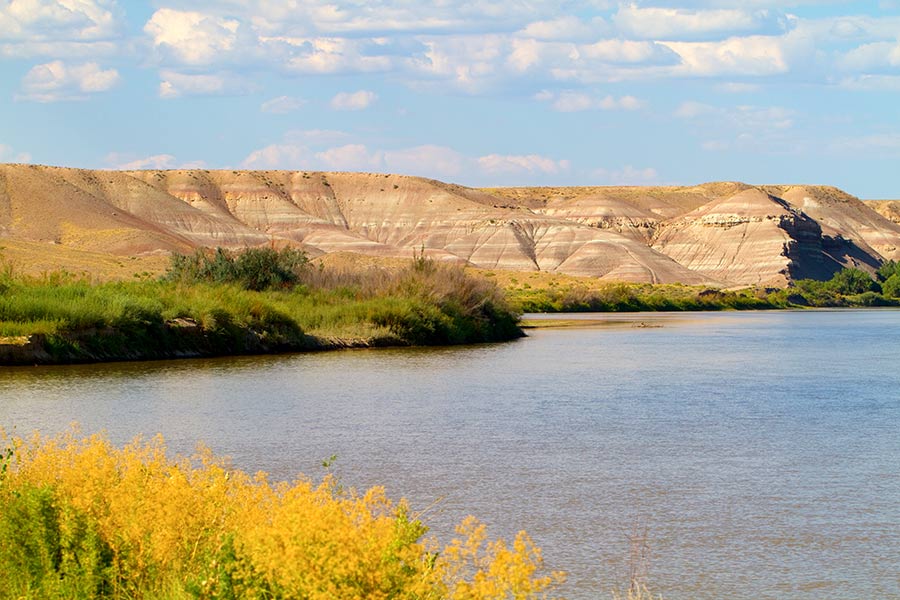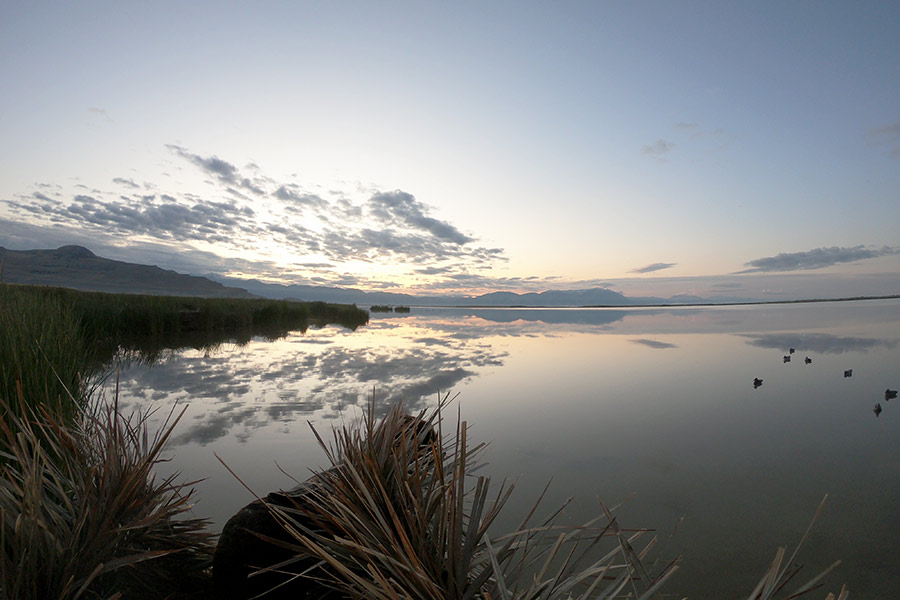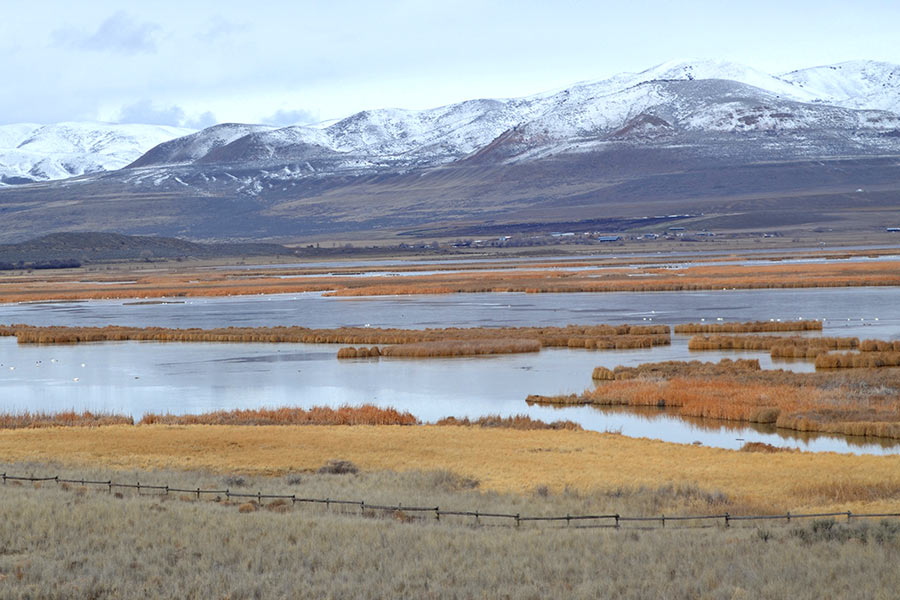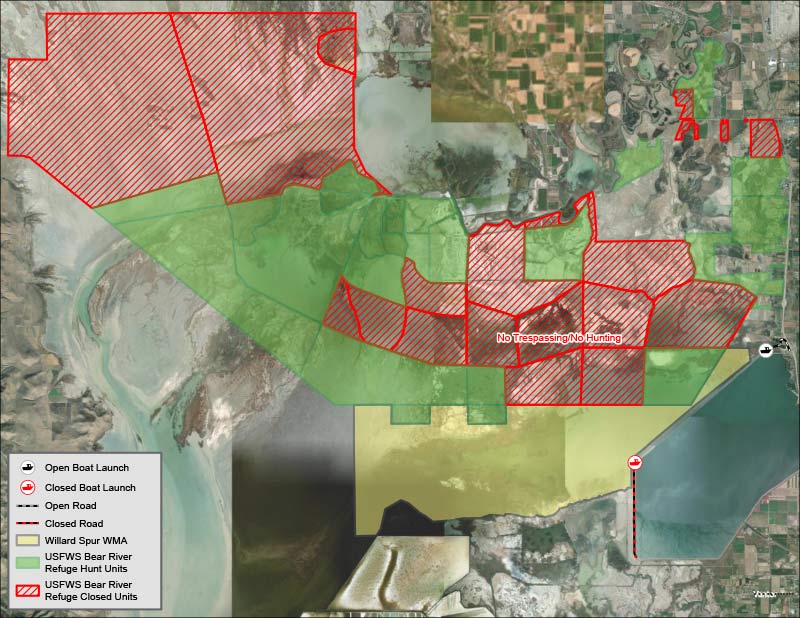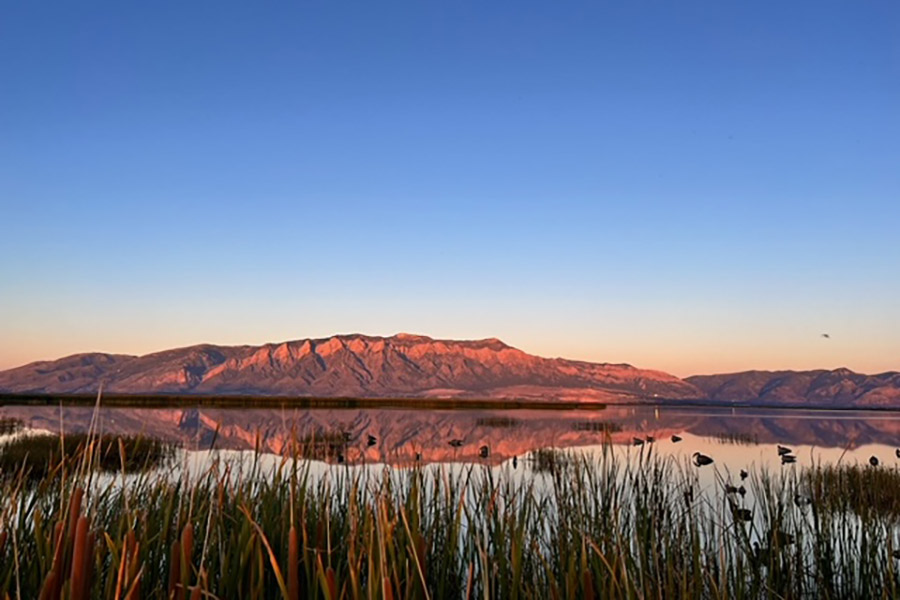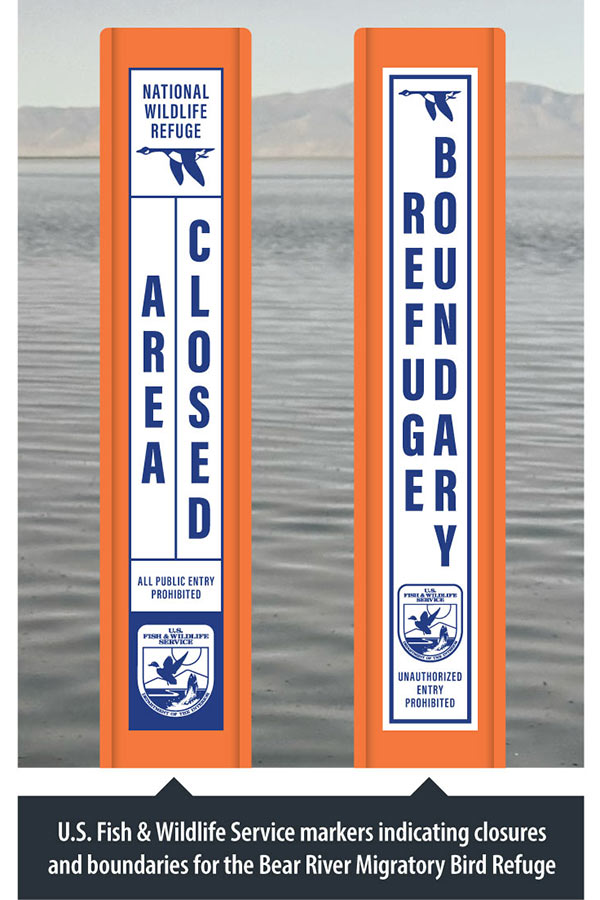Waterfowl hunt opener conditions
Conditions at specific waterfowl areas
The following areas are open to waterfowl hunting as of mid-September 2025. Tap or click each area to view its conditions.
Bear River Bay
Water/marsh conditions: Bear River Bay has been dry all summer. As of Sept. 9 there is very little water at the boat launch. Launch at your own risk. Water has been flowing from the Bear River Migratory Bird Refuge for a little over a week. There should be some water for airboats by the general opener on Oct. 4. However, this is dependent on the amount of water the Bear River Bird Refuge is releasing.
Bird use: Bird numbers are poor to fair where there is water. You should see pintail, green-winged teal, cinnamon teal and some wigeon.
Access: Gates will open Sept. 18. It is unlikely that staff will be able to mow the road and parking lot before the Youth Waterfowl Hunt (Sept. 20). However, both are passable and can be used. The road and parking lot will be mowed before the general opener.
General information: Bear River Bay is in the Northern goose area. Dark Goose hunting will be closed Oct. 12–26.
Bear River Migratory Bird Refuge
The Bear River Migratory Bird Refuge is managed by the U.S. Fish & Wildlife Service.
Access and water conditions: While habitat conditions are improving, boating access may be limited this year due to the ongoing drought affecting much of northern Utah.
- Unit 2C is full and ready for the youth hunt.
- Unit 2D will be at target water levels in time for the youth hunt.
- Units 1A and 2B are currently receiving water and are expected to reach target levels by the general-season waterfowl hunts.
- Unit 3B began receiving water on Sept. 1.
Please see the following resources for more information about hunting and access at the Bear River Migratory Bird Refuge:
Blackhawk WMA
The Blackhawk Waterfowl Management Area was acquired in 2023. Currently, there is no public access to this property. The DWR is actively collaborating with the Salt Lake City International Airport to establish access to the area, with the goal of opening it to the public as soon as possible.
Browns Park WMA
Water/marsh conditions: It has been a very dry year and vegetation and water levels have suffered as a result.
- Ponds at the Headquarters unit are dry.
- Water levels on the Butch Cassidy unit will be close to full.
- The Bridgeport unit will be low.
- Ponds on the Parsons unit will be full until nighttime temperatures reach freezing and the canal will be shut off.
River levels are expected to range from 860 to 2500 cubic feet per second, depending on dam releases.
Access: Road access from Dutch John to the Bridgeport unit is in good condition. Road access to the Parsons and Butch Cassidy units are somewhat rough, but passable. The swinging bridge is open in Colorado and has a maximum width of 8 feet.
Bird use: Current bird numbers are low in ponds due to low water levels, but there are still birds along the Green River corridor. Youth Waterfowl Hunt participants should expect to see birds, which typically decoy well. For the regular season opener, hunters will mostly see mallards, green-winged teal, wigeons and gadwalls. Hunters should expect to see few Canada geese this year.
General information: Water levels will be variable. Storms may wash out roads which will be repaired as quickly as possible.
Clear Lake WMA, Topaz Slough WMA, Redmond Reservoir and Bicknell Bottoms WMA
Marsh/water conditions:
- Clear Lake: The spring flows at Clear Lake are similar to last year with no huntable water available for the opening of the season. The water levels will hopefully increase as the season progresses. The entire WMA has never been this dry. Areas south of the county road have no water. There is no water north of the county road for the beginning of the season. Like last year, the water will begin to fill areas as the weather cools down. The west marsh area continues to be dry. Conditions improve as the season progresses; more ducks show up and water increases with each passing week. With the wet winter and increased moisture in the area, there is optimism for some water to begin increasing on the area. The underground water has not arrived yet.
- Topaz Slough: Marsh conditions at Topaz Slough are completely dry.
- Redmond: Redmond has good conditions on small impoundments, and also has foot access to the Sevier River.
- Bicknell Bottoms: Bicknell Bottoms has excellent conditions. Water levels are good, and waterfowl numbers are up this year. Much work has been done to improve the area for both waterfowl and upland hunting.
Access: All of the areas allow only nonmotorized boats due to shallow water conditions. Camping is allowed at Clear Lake in parking lots, and fires are permitted. ATVs are prohibited on all areas listed.
Waterfowl use:
- Clear Lake: Clear Lake duck numbers increase as the season progresses. Good numbers of ducks show up as soon as the weather turns colder. They are expected to continue increasing with peak numbers around Jan. 1. These ducks begin using flooded annual weeds and can provide some great late-season hunting with easy access. The most common ducks at Clear Lake are mallards, pintails and green-wing teal.
- Bicknell Bottoms: Good numbers of ducks and geese can be found at Bicknell Bottoms. Bicknell Bottoms offers good hunting both early season and late season.
- Redmond: Redmond is generally better for duck hunting earlier in the season.
Upland bird hunting and fishing opportunities: Clear Lake, Redmond and Bicknell Bottoms are all good places to try pheasant hunting. Each area is open for pheasant hunting for 30 days and has excellent habitat for the birds and hunters to enjoy. Please check the current Upland Game & Turkey Guidebook for details and shooting hours. Clear Lake, Redmond and Bicknell Bottoms all receive released pheasants each week during the general pheasant hunt. If hunters are looking to get away from the crowds, try these areas.
Bicknell Bottoms also has excellent trout fishing.
General information:
- Southern duck zone season is open Oct. 11, 2025 through Jan. 24, 2026. The Youth Waterfowl Hunt is Sept. 27.
- Youth pheasant and quail hunting is open statewide Oct. 26–30.
- Steel shot is required to hunt at all times inside Clear Lake and Bicknell Bottoms.
- Gunnison Bend Reservoir is a large rest area in Delta. Many waterfowl stay there during the day and fly off eventually to go feed in the surrounding agricultural fields. Some success is found by scouting and asking permission to hunt private lands.
Desert Lake WMA
Water/marsh conditions: Due to dry conditions in the area, most ponds went dry during the heat of the summer. After summer rains, most of the ponds have water in them. Ponds are currently holding resident birds and migrating birds should arrive soon.
Access: The ponds can be accessed on the county roads that go through the property. Six parking lots can be found along the county roads for waterfowl hunters. No camping is allowed on the Desert Lake WMA. Please use adjacent BLM property for overnight use.
Bird use: Waterfowl numbers have begun to increase over the last month and should remain steady until the general opener. Waterfowl numbers typically go down following the opener until the migration begins. There should be waterfowl present for the Youth Waterfowl Hunt and they should decoy well. Common species present include widgeon, gadwall, mallard, green-wing teal, redheads, Canada geese and coots.
Farmington Bay WMA, Timpie Springs WMA & Layton-Kaysville WMA
Water/marsh conditions:
-
Farmington Bay WMA: Wetland conditions within the impounded units at Farmington Bay WMA are currently favorable and progressing well in preparation for the upcoming waterfowl season. While impounded units are on track to reach desired hunt levels by Oct. 4, water levels outside of these areas remain variable due to natural fluctuations.
Note: Unit 2 and Teal Lake will not be at hunt levels in time for the Youth Waterfowl Hunt on Sept. 20.
Habitat conditions across interior sheet-flow wetlands and impoundments are excellent, supported by recent and ongoing management actions. Invasive phragmites have been effectively controlled through targeted herbicide treatments and rotational cattle grazing. Herbicide applications were completed in August 2025 along dike lines and accessible areas using Marsh Masters, tracked vehicles, and road equipment. Grazing was conducted this summer in the Turpin Unit to further enhance habitat quality.
Further grazing treatments were implemented in several other key areas, including north of Turpin, Unit 1, South Drawdown, West Crystal, Doug Miller and the Davis Creek area. These efforts are expected to enhance loafing habitat for waterfowl and improve hunter access throughout the management area.
- Timpie Springs WMA: Although Timpie Springs WMA is a relatively small wetland complex, it currently exhibits good to excellent marsh conditions. The area consists of two large impoundments, sheet-flow wetlands, mudflats and upland habitat, totaling approximately 1,440 acres. Both ponds are currently full and overflowing into adjacent wetlands and flats. Vegetation is characterized by low-standing saltgrass and scattered bulrush species, creating favorable habitat for early migrating waterfowl.
- Layton-Kaysville Wetlands: Marsh conditions at Layton-Kaysville are fair to poor, primarily due to phragmites encroachment and low water levels.
- Airboat conditions: Airboating conditions across the shallow bays of the Great Salt Lake appear favorable heading into the waterfowl season. However, hunters are advised to use caution as fluctuating vegetation, submerged hazards, and expansive mudflats outside diked units in Farmington Bay, the Layton-Kaysville Wetlands and the open waters of the Great Salt Lake may present navigational challenges. Water will be released from the airboat launch as long as impounded and sheet-flow units maintain optimal levels.
Access:
- Farmington Bay WMA access points will open Thursday, Sept. 18, 2025, at 8:00 a.m. A wakeless speed is recommended in all impoundments due to submerged hazards. Hunters should consider bird retrieval logistics when selecting a hunting location.
- Timpie Springs WMA is open to public access year-round.
- Gaily Wetlands will open to the public beginning Sept. 18, 2025 (two days prior to the Youth Waterfowl Hunt, occurring on Sept. 20).
- The Layton-Kaysville access point near Rouche Lane in west Farmington has been permanently closed. It has been replaced by a new access at the 950 N exit off the West Davis Corridor, which will open Sept. 18, 2025.
Bird use: Currently, large concentrations of ducks and geese are present at Farmington Bay WMA. Habitat improvements and scheduled flooding of sheet-flow wetlands in mid-September are expected to enhance bird distribution throughout the area.
Hunters can expect strong early-season numbers of cinnamon teal, gadwall and pintail. Diving ducks typically arrive later in October. Tundra swan harvests usually peak from mid-to-late November, while dark goose hunting tends to improve during the extended goose season.
General information:
- The northwest corner of Unit 1 is designated as a waterfowl rest area and is closed to hunting and trespass.
- The area west of the main entrance road to the first right bend, and north to Goose Egg Island, is closed for educational purposes.
- Shooting is prohibited within 600 feet of all dikes and any motorized road at Farmington Bay WMA.
- Airboats are prohibited within diked units.
- The South Crystal Unit is designated as a motorless area.
- Camping is allowed only in designated parking areas. Open fires are prohibited. Please pack out all trash to help us maintain these privileges.
- The ADA hunting blind is available by reservation only. Contact David England at 385-405-4852 or Wyat Hansen at 385-588-4623 for reservations and rules.
Fish Springs National Wildlife Refuge
The Fish Springs National Wildlife Refuge is managed by the U.S. Fish & Wildlife Service.
Please see the following resources for more information:
Harold Crane WMA
UPDATE: Ongoing construction has impacted access to the south boat ramp of the Willard Spur Waterfowl Management Area. The Harold Crane WMA remains open during the construction, but please use caution when entering and exiting the area.
Water/marsh conditions: Generally, marsh and impoundment conditions are great.
- Main impoundments: There is excellent aquatic vegetation growth in the south impoundment. The east and west impoundments were also flooded and have excellent aquatic vegetation growth. In addition to the aquatic vegetation, a lot of alkali bulrush has germinated and is growing within the impoundments.
- Exterior flats: There are great conditions on flats to the east. Areas north and west of the impoundments are beginning to flood.
- Rainbow Unit: The Rainbow Pond is filling with water and should have water throughout the hunt. The area north of the Rail Trail also looks good on the east end. It was burned and then grazed by cattle and has good water.
Access:
- Gates will be opened on Thursday, Sept. 18.
- The road with three parking lots accessing the west Rainbow Unit is in good condition. The main Harold Crane parking lot has been improved, also.
- The federal Bureau of Reclamation road to Harold Crane through Willard Upland Game Bird Area is in fair shape because of the hard work that our waterfowl maintenance crew has done. The headgate bridges are slightly narrower than the road, so be careful.
Bird numbers:
- Main impoundments: Great numbers of ducks on all three impoundments. The south side of the impoundments where the cattle have grazed also have great numbers of ducks.
- Rainbow Unit: Fair number of birds north of the Rail Trail in the phragmites treatment area.
Goose numbers are good overall.
General information: Hunting should be great for the Youth Waterfowl Hunt and general opener.
Howard Slough WMA
Water/marsh conditions: Conditions are great in main impoundments. Water is at full pool/spilling levels and contains excellent sago pondweed growth. Conditions outside of the north impoundment are also excellent thanks to intensive cattle grazing. The area west of the south impoundment is very overgrown with phragmites. This area was all sprayed by helicopter and should be opened up next year. Some seasonal, small ponds on the Hooper Hot Springs Unit are low and/or dry.
Access: The access road will be graded. Gates will be opened on Thursday, Sept. 18, 2025.
Bird numbers: Great bird numbers are in main impoundments. The grazed area has a lot of birds. Generally, duck numbers have been holding well, and goose and swan numbers have increased here substantially in the last few years.
General information: Howard Slough WMA had some of the best WMA Youth Waterfowl Hunt success in the region the last few years and should be great again this year. It should hunt well throughout the season also. For its size, it holds up very well under extremely heavy hunting pressure, and tundra swan hunting is expected to be good later on.
Locomotive Springs WMA
Water/marsh conditions: The water levels are very low and impoundments are dry.
Access: Roads are a little rough. Gates will open Sept. 18.
Bird use: Bird numbers are extremely low. Mallards, pintails and green-winged teal are the primary birds. There are very few Canada geese.
General information:
- Locomotive Springs WMA is in the northern goose area. Dark goose hunting will be closed Oct. 12-26.
- Camping is allowed in established parking areas, but there are no facilities available.
- Fires are the responsibility of the camper, and if you lose it, you pay for it. Please be aware of state fire restrictions and follow those rules accordingly.
Ogden Bay WMA
Water/marsh and impoundment conditions:
- Unit 1: Pondweed growth is great on the main impoundment and excellent in the secondary impoundments. Over 1,000 acres of phragmites on the east side of the open water have been successfully grazed, but not as good as years past. The cattle were playing catch up after last year to open up the area and did a much better job than last year. West of Unit 1 there was cattle grazing and the area is very open.
- Unit 2: Cattle were in the area this summer and they did an excellent job! The old dike will be rebuilt next summer. The area should be totally flooded by the end of September.
- Unit 3: Pondweed growth is excellent this year. Cattle have grazed the east side of the open water. Be advised that the rest area is in place on Unit 3. The rest area is very well posted and there is absolutely no trespassing allowed in this area. The rest area consists of the two small impoundments that are on the south side of the road as you head to the Unit 3 boat launch. All phragmites east of the open water were sprayed by helicopter. Managers are hoping to burn the area in the spring. All phragmites west of the dike were also sprayed by helicopter. Managers are hoping to burn this area as well in the spring.
- Weber Delta: South Weber Delta was much drier this summer than last year and is in good condition. There is water in the river impoundment and most ponds at the north entrance. Sago pondweed growth was great in this area.
- Pintail: There were over 1,000 acres of phragmites sprayed in this area in 2024. This area is much more open than it was last year, but there was an abundance of water in this area all summer long. The habitat should be better than it was in years past because of successful spraying and successful cattle grazing.
Generally, all major impoundments are full and overflowing onto the westward flats. Marsh conditions are good to excellent in most areas. The current Great Salt Lake elevation is 4191.3 feet.
Access: All outer gates to lower parking lots and boat launches will be open on Thursday, Sept. 18. There is good vehicle access with most roadways and parking lots mowed and in good shape. Most access roads will be graded by the general opener.
Unit 1 boat channel into main impoundments is clear and usable. The Unit 3 boat channel will be clear and usable.
Bird numbers: Duck production was excellent once again this year. Thousands of ducks were produced at Ogden Bay, Howard Slough and Harold Crane WMAs.
- Unit 1: Great bird numbers are present in the main impoundments. Great numbers of birds are starting to build in the larger interior flats, which were reopened by grazing and are now flooded. Good numbers of ducks are starting to use secondary ponds, also.
- Unit 2: Bird numbers are increasing with additional water in the area. Farther west flats and far north-end ponds are expected, like last year, to gain a large number of birds when these areas totally refill and interior hunting forces them out there.
- Unit 3: Good bird numbers in the main impoundment. The west flats are nearly overgrown with phragmites, but they were all sprayed by helicopter this fall. The area is flooded, but there isn't much area available for bird use. The east flats have good numbers of birds.
- Weber Delta: Fair numbers in general on North Weber Delta and fair numbers on South Weber Delta, but numbers will increase as these areas refill.
- Pintail: Great numbers now, with an expectation of increasing to excellent numbers later on west side flats toward the Great Salt Lake.
Generally, birds are mostly concentrated on larger impoundments or ponds and flats in Unit 1 and 3. Remote ponds and flats west of impoundments will increasingly hold larger numbers of birds as they are displaced in easily accessible areas by hunters' pre-hunt scouting activities and the Youth Waterfowl Hunt.
General information: The Youth Waterfowl Hunt should be great in the main impoundments and adjacent flats. The general opener should also be great. Hunting should be good as the season progresses and new birds arrive after all the pre-hunt scouting and weekend pressure subsides. In general, hunters will find the best hunting in the better habitat and bird concentration areas detailed above. Duck production was incredible nearly everywhere and there are going to be a lot more young and inexperienced birds flying around this year.
Ouray National Wildlife Refuge
The Ouray National Wildlife Refuge is managed by the U.S. Fish & Wildlife Service.
Please see the following resources for more information:
Public Shooting Grounds WMA
Water/marsh conditions: Water conditions have been poor to fair this year.
- A number of ponds went dry this summer including Mud Lake and Spires on North Public, and Avocet Pond and Wigeon Lake on South Public.
- Wetlands outside of impoundments — including south of Hull Lake, south of Wigeon Lake, Wigeon Marsh, sections of Pintail Marsh and the West Marsh — have been dry most of the summer.
- As of Sept. 9, all ponds and lakes on Public Shooting Grounds are near full pool and spilling into adjacent marshes with the exception of Wigeon Lake.
- Wigeon Lake is starting to fill and will have some water to hunt, but motorless boat access could be difficult. Managers anticipate it will be full by the general opener on Oct. 4.
- All other ponds will be full for the Youth Waterfowl Hunt. Water outside of impounded areas will be sparse for the Youth Waterfowl Hunt.
- Managers have started to spill water south of Hull Lake but are unsure when water will reach south of Wigeon Lake and the West Marsh. Hull Lake, Pintail Lake and Duck Lake (rest area) held water all summer and produced fair to good amounts of pondweed.
Access: Gates will open the afternoon of Sept. 18. All roads and parking lots have been (or will be) mowed and graded before the general opener. Speed bumps and a speed limit of 15 mph have been installed on the main road near the blinds designated for physically challenged hunters. Please be careful and slow down.
Bird numbers: As of Sept. 9, bird numbers are increasing daily. They should continue to build in numbers as we approach the Youth Waterfowl Hunt and general opener. Mallards, pintails, green-winged teal, gadwalls, cinnamon teal and some redheads are present now. Wigeons are starting to show up in good numbers. There are also a good number of Canada geese right now.
General information:
- Public Shooting Grounds WMA is in the Northern goose area. Dark goose hunting will be closed Oct. 12–26.
- Camping is allowed in established parking areas, but with no facilities available.
- Fires are allowed in fire pits only and are the responsibility of the camper, if you lose it, you pay for it. Please be aware of state fire restrictions and follow these rules accordingly.
- Please respect posted signs and regulations along with regulations in the current Utah Waterfowl and Migratory Game Birds Guidebook.
- Blinds for physically challenged hunters are available on a first-come, first-served basis. You must possess a DMV-issued physically challenged sticker or license plate to use these blinds.
- Wigeon Lake is a nonmotorized-boats-only lake.
- North Public Shooting Grounds (north of Highway 83) is still closed to tundra swan hunting.
- Remember: The harvest of trumpeter swans is illegal; see the Utah Waterfowl and Migratory Game Birds Guidebook for more information about swan regulations.
Salt Creek WMA
Water/marsh conditions: All of Salt Creek WMA held water throughout the summer except for Stilt Pond in the northwest corner of the WMA. The units on the east side of Salt Creek, Gadwall, Canvasback, Redhead, Mallard Teal and Goose were full all summer and produced good to excellent pondweed. Both Ibis and Snipe ponds held water all summer; however, pondweed production was poor due to excessive carp numbers. The main bay of Salt Creek produced good to excellent pondweed. Managers anticipate having full water levels for both the Youth Waterfowl Hunt and general opener.
Waterfowl use: As of Sept. 9, bird numbers are excellent and increasing daily. Hunters should see mallards, pintails, green-winged teal, gadwalls, cinnamon teal and wigeon at Salt Creek. There are a good number of Canada geese around right now.
Access: Gates will open the afternoon of Sept. 18. All roads and parking lots have been (or will be) mowed and graded before the general opener. Please be careful and slow down on WMA roads.
General information:
- Salt Creek WMA is in the Northern goose area. Dark goose hunting will be closed October 12–26.
- Camping is allowed in established parking areas, but there are no facilities available.
- Fires are allowed in fire pits only and are the responsibility of the camper, and if you lose it, you pay for it.
- Please be aware of state fire restrictions and follow these rules accordingly.
- Please respect posted signs and regulations along with regulations in the Utah Waterfowl and Migratory Game Birds Guidebook.
- Salt Creek WMA is closed to tundra swan hunting.
- Blinds for physically challenged hunters are available on a first-come, first-served basis. You must possess a DMV-issued physically challenged sticker or license plate to use these blinds.
Willard Spur WMA
UPDATE: Due to ongoing construction and safety concerns, the north boat ramp and its associated parking area is currently the only access point to the Willard Spur Waterfowl Management Area. The south boat ramp and all southern access will be closed until further notice.
As mentioned, you can still access the Willard Spur WMA via the northeastern access point. The road that used to provide access to the northern parking lot now has a Utah State Parks tollbooth on it — do not turn there. Instead, stay on the paved road and travel slightly farther, passing the Willard Bay State Park entrance. When you come to the "T" in the road, turn left. This road will lead you directly to the north parking lot of the Willard Spur WMA.
Water/marsh conditions: The Willard Spur WMA benefited from substantial water deliveries this summer, with over 100,000 acre-feet released from Willard Bay Reservoir. As a result, water levels are currently much higher than average for this time of year. While the added water has created good wetland conditions in some respects, it has also allowed carp numbers to surge — possibly reaching record highs. This situation stems from several factors working together: Consistently high water levels that prevented natural carp die-offs, the unusually large runoff events of 2023 that flushed fish out of Willard Bay and surrounding areas, and this year's strong reservoir releases. Together, these conditions have created a perfect environment for carp expansion while suppressing beneficial vegetation growth.
This increase in carp has reduced aquatic vegetation, especially sago pondweed, which is an important food source for waterfowl. Even with lower pondweed production, overall habitat conditions should still support good hunting opportunities this season.
Invasive species management: Efforts to control invasive phragmites continued this fall across the WMA. Crews treated 1,000 new acres by air, and followed up with ground treatments on another 800 acres. These efforts are part of an ongoing, multi-year strategy to reduce phragmites and restore wetlands to native and desirable plant communities. Additional work will continue through the winter and spring to build on these gains and improve habitat quality for both wildlife and hunters.
Bird numbers: Bird activity at Willard Spur WMA is looking great this season. Nesting success was solid, with many local birds raising broods across the area. In recent weeks, teal, northern shovelers and pintails have been moving through in fair numbers. Most flocks are currently concentrated in larger open-water areas, but as hunting pressure increases, they will likely shift toward the more remote ponds and shallow flats along the WMA's edges.
Access: In case you are new and did not see this last year, the main parking lot has changed slightly. The road that used to take you to the parking lot now has a Utah State Parks tollbooth on it: Do not turn there. Instead, stay on the paved road and travel slightly farther, passing the Willard Bay State Park entrance. When you come to the "T" in the road, turn left. This road will lead you directly to the north parking lot of Willard Spur WMA.
General information:
- The Youth Waterfowl Hunt should be good in the central area of the Spur, and the general opener should also be good.
- The adjacent flats along the exteriors of the WMA may be lacking water in some areas. Weather will largely dictate whether water levels rise later in the fall.
- Hunting should be fair as the season progresses and new birds arrive after pre-hunt scouting and opening-weekend pressure subside.
- Hunters will generally find the best success in areas with stronger habitat conditions and fair bird concentrations.
- The WMA shares a boundary with the Bear River Migratory Bird Refuge. Much of the refuge that borders the WMA is open to hunting, but two sizable portions are not. The U.S. Fish & Wildlife Service has marked these boundaries with signs (see image here). Please watch for these signs to ensure you are in an area open to hunting — travel through restricted areas is strictly prohibited.
Maps
Tap or click the following areas for maps:
Waterfowl Management Areas
National wildlife refuges
- Bear River Migratory Bird Refuge
- Fish Springs National Wildlife Refuge
- Ouray National Wildlife Refuge
If you have questions about waterfowl hunt opener conditions or Waterfowl Management Areas in northern Utah, contact the DWR Northern Region office at 801-476-2740 or Salt Lake office at 801-538-4700.


